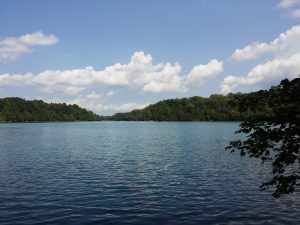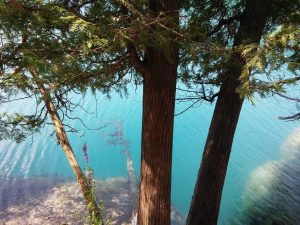Green Lakes State Park
 |
| “Life is not measured by the number of breaths we take, but by the moments that take our breath away.” George Carlin |
Time stood still as we walked around the lakes.
It was difficult not to stop and stare.
With every step another wonder!
The Colors!
looking down, farther down
past the trees trunks strewn along the shore
even deeper, and deeper still
until I noticed
somehow,
the deepest green had become the deepest blue!
pumpkinseed sunfish!
so bright and clear
somehow they disappeared
right in front of my eyes.
their stillness was remarkable and admirable.
deeper in the woods,
gazing across the lake,
the sky reflected the water!
a beautiful illusion.
immortal tease!
billowing clouds, lazily drifting across everything blue.
This secret world
with ancient trees
beckons adventure.
Deep, “Green,” And Meromictic: Glacial Jewels of Green Lakes State Park
Green Lake has 65 surface acres and is about 195 feet deep. Round Lake, a National Natural Landmark has 43 surface acres and is 170 feet deep. These pristine lakes, occupying glacially-carved basins, have many unique features, including unusual chemistry, shoreline reefs, and meromixis.
 |
| Green Lake – August 9, 2017 |
 |
| Green Lake – September 26, 2017 |
 |
| Round Lake – August 9, 2017 |
 |
| Round Lake – September 26, 2017 |
What is a Meromictic Lake?
Green and Round Lake are two of only a few lakes worldwide that do not experience “turnover,” or mixing of the upper and lower water masses. Several factors contribute to this complex and unusual condition known as meromixis. Differences in density and salinity between the upper and lower water masses; the lakes depths and surface areas; and their locations in deep basins with tree-rimmed shorelines that protect the water from strong winds are all conditions thought to help prevent turnover.
All the Colors of the Rainbow: Why the Lakes are Green
Green & Round Lakes – Often described as aquamarine or turquoise, their water is actually very clear. As you move along the lake trail, observe the water in different locations. You’ll enjoy all the color variations of blue and green.
As a light ray penetrates water, it separates into the spectrum of all colors of the rainbow. Each spectral color corresponds to a specific wavelength of light. The red wavelengths scatter little and are absorbed near the surface. The green and blue wavelengths pass through the clear water to a greater depth where they are reflected back to your eye.
Deadman’s Point: An Ancient But Living Reef
Although known as “Deadman’s Point”, this freshwater reef is both alive and growing! For thousands of years, microscopic organisms called cyanobacteria have lived in the reef’s surface, using sunlight and nutrients dissolved in the lake water to build the reefs. The nutrients are deposited on the reef, creating a type of limestone called marl that hardens to form the reef structure.
This unique and beautiful ecosystem is very fragile. Some organisms that live on the reef have existed on earth for millions of years. However, stepping on the reef can destroy them, and without these organisms the reef will no longer grow. Without the reef’s protective canopy, the plants and animals living underneath will also die.
The reefs along the shores of Green Lake provide homes for many organisms. The green and brown patches on reefs are microbial mats made by ancient organisms. Below the reefs, rare sponges and mosses grow from ledges and caves. The mosses provide hiding places and protection for fish and other animals.
 |
| Deadman’s Point – August 9, 2017 |
 |
| Freshwater Reef – August 9, 2017 |
 |
| Deadman’s Point – September 26, 2017 |
Colorful and Busy Bacteria
Although bacteria are too tiny to be observed, here at Green Lakes the results of their activity may be seen and appreciated.
Approximately 55 to 75 feet below the lake surface is a three-foot thick layer of rosy-brown water created by the presence of photosynthetic purple and green sulfur bacteria.
At least three groups of bacteria that convert sunlight into food live in the lakes. At the surface, small cyanobacteria (cyano = blue) and diatoms (a type of algae) provide the main food source for zooplankton, which in turn provide food for other aquatic animals higher on the food chain.
Near the lakeshore, cyanobacteria combine with and precipitate calcium carbonate, forming interesting reefs around the lakeshore. The reefs provide a substrate for aquatic plants and shelter for fish.
 |
| Freshwater Reef – August 9, 2017 |
 |
| Freshwater Reef – September 26, 2017 |
 |
| Freshwater Reef – September 26, 2017 |
Round Lake: A National Natural Landmark
In 1973, Round Lake and 100 acres of the surrounding forest became our nation’s 182nd National Natural Landmark. This designation by the U.S. Department of the Interior is “reserved for resources that are sensitive and unique and which represent the natural heritage of our country.”
The lake which covers 34 acres and is 170 feet deep is of national ecological and geological significance due to its glacial origin, meromictic (non-mixing) character, and its adjacent old-growth forest. This forest, which has abundant bird life and some of the oldest trees in the country, may be seen southwest of the lake. Enjoy the spirit of this magnificent forest and lake setting as you explore this special environment.
 |
| Round Lake – August 9, 2017 |
 |
| Round Lake – August 9, 2017 |
 |
| Looking into Round Lake – September 26, 2017 |
Green Lakes State Park is an amazing place to visit. There is a vehicle fee during certain times of the year (I believe from Memorial Day to Labor Day it is $8), but the park also has boat rentals, a swimming beach, a changing area for the beach, concessions, as well as public restrooms and drinking fountains.
I easily see myself visiting Green Lakes State Park again. There is still so much more to discover!
I would love to go back and see the old-growth forest. A sign near Round Lake reads, “Some of the Eastern Hemlocks located in the old-growth forest southwest of Round Lake are more than 90 feet tall and over 400 years old.”
I would also go back just to investigate the Indian Ovens, which somehow I missed on the park map repeatedly, until just recently.
All information shared was gathered from signs within Green Lakes State Park.
Fayetteville, Town of Manlius, NY
All photos were taken by me (Alicen).
My good friend Tambre & her daughter Micheala shared the park with me in August for the first time.
Tambre and I went again at the end of September hoping for some autumn foliage.


